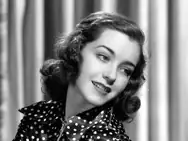Jigsaw
Cast & Crew
Fletcher Markle
Franchot Tone
Jean Wallace
Myron Mccormick
Marc Lawrence
Winifred Lenihan
Film Details
Technical Specs

Synopsis
After New York City printer Max Borg is murdered, District Attorney Walker, who is assigned to the case, learns that Borg, who had recently been exposed as the printer of propaganda posters for a race hate group called "The Crusaders," was apparently silenced by them. When an article about the group appears in a local newspaper, Walker's deputy, Howard Malloy, visits the author, Charles Riggs, who is also his sister Caroline's fiancé. Later, Charlie is followed home by a mysterious figure, who knocks him unconscious and pushes him out of his high-rise window. After Caroline finds a propaganda poster inside Charlie's room and shows it to Howard, he notices the words "Sigmund Kosterich, Rembrandt Studios" printed on the back. Howard goes to Kosterich's shop, posing as a potential customer, but Kosterich insists he does not print posters. Before leaving, Howard admires Kosterich's painting of a lovely singer named Barbara Whitfield. When a man follows Howard home, Howard draws his gun, grabs the man's wallet and learns that his name is Miller. Inside the wallet, he finds a newspaper advertisement for Barbara's nightclub act and a card with an address and the words "See the Angel" printed on it. Howard goes to the address, which turns out to be the headquarters of the Mohawk Political Club. There, he introduces himself to "The Angel," Angelo Agostini, who offers to help him win a promotion to special prosecutor. Later, when Howard's friend, socialite Grace Hartley, hears Howard's name linked to Angel's, she warns him against associating with unsavory characters. Howard attends a party at Grace's house, then leaves after receiving a message from his partner, Tommy Quigley. After her show at the Blue Angel nightclub, Barbara meets Howard, and although she is Angel's sweetheart, Howard kisses her. When Angel sees Barbara with Howard, he becomes jealous and orders her to break it off with him. Later, Barbara tells Howard about The Crusaders' racist agenda, and when he tries to kiss her, she surmises that he is only after information and pushes him off the couch. Howard is knocked unconscious when his head hits the coffee table, and while he is unconscious, Grace, the secret head of The Crusaders, arrives, shoots Barbara to death and escapes. Howard revives, and when Kosterich shows up, Howard assumes he is the murderer. Kosterich blames Grace, who unknown to him, is eavesdropping in the hallway outside, then tells Howard that he found evidence of her involvement with The Crusaders while painting a portrait at her house. When Grace overhears Kosterich say that he has hidden the evidence behind one of his paintings at the museum, she rushes out, followed by Angel and Miller, who is also known as "Knuckles." At the museum, Grace knocks out the night watchman, while Howard phones Quigley and tells him to come to the museum. After Howard and Kosterich arrive and find the watchman, Howard goes after Angel, while Kosterich creeps up behind Grace. Howard then shoots Angel, and Grace shoots Kosterich. When Miller arrives and fires at Howard, Kosterich grabs Howard's gun and shoots Grace. Just then, several squad cars arrive at the scene, and Caroline is so relieved to see that her brother is unhurt that she kisses him.

Director
Fletcher Markle
Cast

Franchot Tone

Jean Wallace

Myron Mccormick
Marc Lawrence
Winifred Lenihan
Betty Harper
Hedley Rainnie
Walter Vaughn
George Breen
Robert Gist
Hester Sondergaard
Luella Gear
Alexander Campbell
Robert Noe
Alexander Lockwood
Ken Smith
Alan Macateer
Manuel Aparicio
Brainerd Duffield

Burgess Meredith

Henry Fonda

John Garfield

Marlene Dietrich
Fletcher Markle

Marsha Hunt
Leonard Lyons
Crew
Edward J. Danziger
Edward J. Danziger
Harry Lee Danziger
Harry Lee Danziger
Don Malkames
Fletcher Markle
Robert Matthews
Vincent Mcconnor
William L. Nemeth
David M. Polak
John Roeburt
Fred Ryle
Sal J. Scoppa Jr.
Robert W. Stringer

Film Details
Technical Specs

Quotes
Trivia
Notes
The opening credits identify the nightclub used for location shooting as the Blue Angel Night Club in New York City. The closing credits include the following acknowledgment: "This picture was filmed with the obvious good will of many famous stars. The producers wish to thank them." A March 28, 1949 Hollywood Reporter news item noted that producer Harry Lee Danziger and the staff at Eastern Sound Laboratories in New York City "devised a collapsible dolly and special hangers for lights" for interior shooting. According to a December 1948 article in American Cinematographer, the picture was shot entirely without sound. Danziger and his brother, Edward J. Danziger, had been using a highly successful technique of sound dubbing to dub foreign films and decided to use it for Jigsaw, their first feature production. The Hollywood Citizen-News noted "a recording defect which makes the sound fuzzy, occasionally unintelligible, and frequently out of synchronization with the players' lips." American Cinematographer reported that the producers' search for "natural settings" led them to New York, where "not a single set was built for the entire production. Even the props were those found on the locations." Locations included the interior of the Brooklyn Museum, a Fifth Avenue pet shop, a night club, a large restaurant "of unique design," an apartment house interior and a warehouse. Jigsaw marked the screen directing debut of Fletcher Markle, who, along with Winifred Lenihan and many other cast members, had worked mainly in radio. Franchot Tone and Jean Wallace were married at the time of the production, but divorced shortly thereafter.












